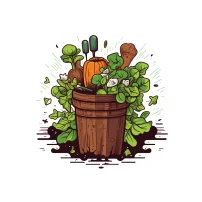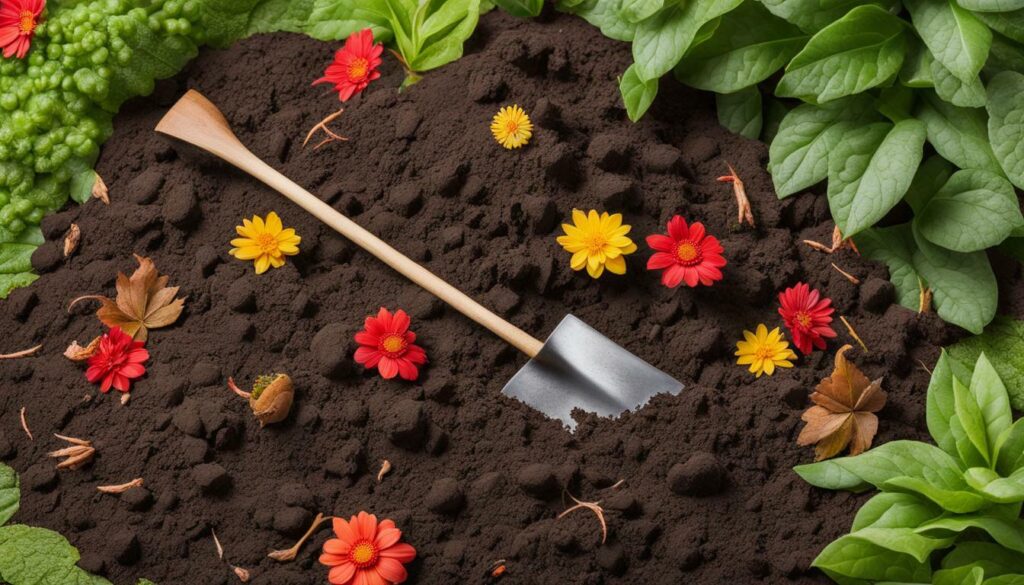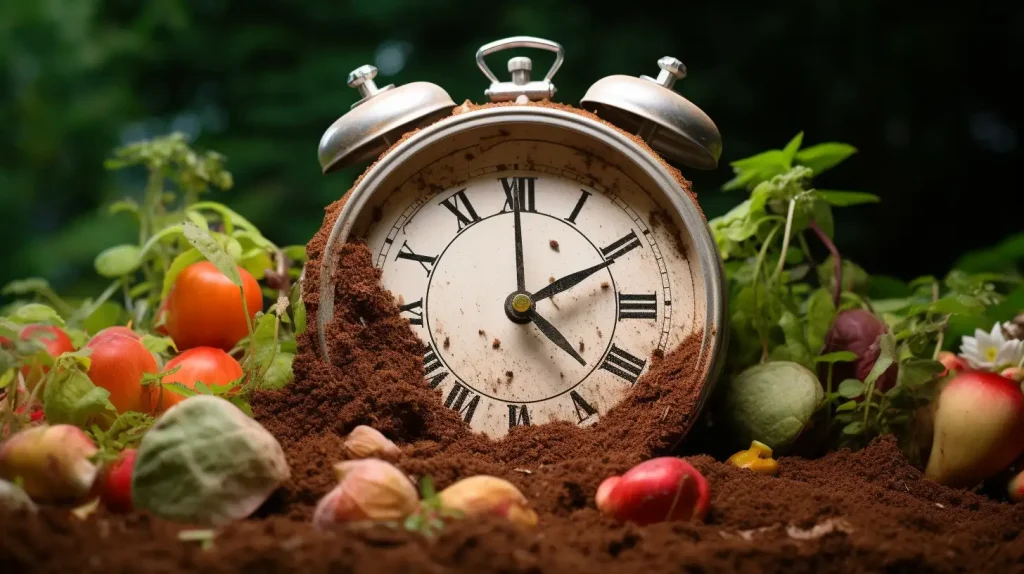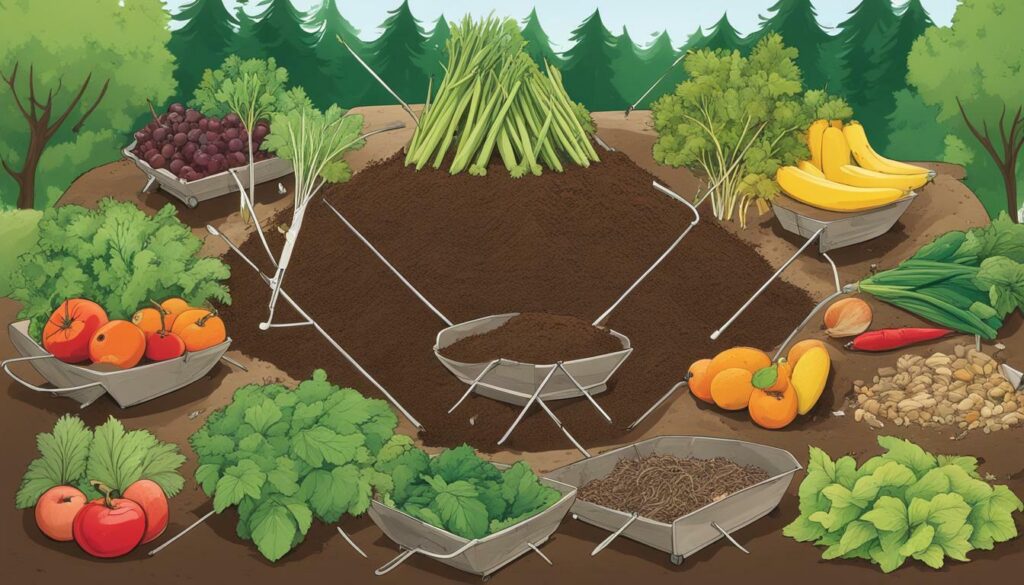Composting at home is an easy and effective way to reduce waste and nourish your garden naturally. It requires little effort and offers a host of benefits. Whether you have a small balcony or a large backyard, home composting is a great way to get started.
In this beginner’s guide, we will discuss everything you need to know about composting at home, from understanding the process to choosing the right method for your space and collecting composting materials. By the end of this guide, you’ll be equipped with the knowledge to create nutrient-rich compost for your garden while reducing your ecological footprint.
Key Takeaways
- Composting at home can reduce waste and improve soil health naturally.
- Understanding the composting process and choosing the right method for your space is key.
- Collecting compostable materials, creating a compost pile or bin, and maintaining the compost are essential steps to successful home composting.
Why Should You Start Composting at Home?
Composting is an eco-friendly activity that offers numerous benefits, making it a great choice for anyone looking to reduce their environmental footprint. Below are some of the key benefits of home composting:
| Benefits of Home Composting |
|---|
| Reduces landfill waste by diverting organic materials from the trash |
| Improves soil health and fertility by adding beneficial microorganisms and nutrients |
| Reduces the need for chemical fertilizers and pesticides |
| Helps retain soil moisture and prevent erosion |
| Encourages biodiversity by attracting beneficial insects and wildlife to the garden |
The composting process at home is also relatively simple and cost-effective. By using organic materials that are readily available, such as kitchen scraps and yard waste, you can create nutrient-rich compost that can be used to nourish your garden.
Not only does home composting help benefit the environment and your plants, it also provides a sense of satisfaction and accomplishment in creating something useful out of waste.
Understanding the Composting Process
Composting at home is a natural and sustainable way to reduce waste and enhance the health of your garden. To get started, it’s important to understand the process of composting. Creating a thriving compost pile involves a few key components, including organic materials, oxygen, moisture, and microorganisms.
The composting process can be broken down into two main types: aerobic and anaerobic. Aerobic composting is the most common method used in home composting. It requires oxygen to facilitate the breakdown of organic matter by microorganisms. Anaerobic composting, on the other hand, occurs in the absence of oxygen and can produce unpleasant odors.
Composting Techniques
There are several different techniques that can be used for composting at home. The most common methods include:
- Compost Bins: A container used to hold and aerate organic materials while they break down. A bin can be made from a variety of materials, including plastic, wood, and metal.
- Tumblers: A sealed container that can be rotated to aerate and mix the compost materials. Tumblers are often more efficient and produce compost more quickly than traditional bins.
- Vermicomposting: A method that uses worms to break down organic matter into nutrient-rich compost. Vermicomposting can be done indoors or outdoors and is ideal for those with limited outdoor space.
Regardless of the technique used, proper layering and maintenance of the compost pile are essential for success.
Choosing the right composting method for your home
Home composting for beginners can seem overwhelming with the various methods available. Choosing the right composting technique depends on personal preferences, available space, and time commitment. Here are some common composting techniques:
| Composting Method | Description |
|---|---|
| Compost bin | A compost bin is a container used to hold organic materials and provide suitable conditions for decomposition. It can be made of wood, metal, or plastic and is available in different sizes and shapes. Compost bins have a lid to prevent pests and rainwater from entering the compost. |
| Compost tumbler | A compost tumbler is a drum-like container that rotates to mix and aerate the compost. It requires less manual turning and effort compared to a compost bin. Compost tumblers are available in different sizes and shapes and are suitable for smaller yards or balcony gardens. |
| Vermicomposting | Vermicomposting is a process of composting with worms. It is suitable for indoors or balconies and requires a worm bin, bedding materials, and red worms. The worms eat the organic matter and excrete nutrient-rich worm castings. Vermicomposting produces compost faster than traditional composting methods and is suitable for smaller amounts of organic waste. |
Consider the pros and cons of each technique before deciding on the best composting method for your home. A compost bin may be suitable for larger gardens where there is more organic waste, while a compost tumbler or vermicomposting may be more suitable for smaller homes or apartments.
Collecting composting materials
Home composting for beginners requires a good understanding of the materials needed to create a nutrient-rich compost. Composting materials are typically categorized as “green” or “brown.” “Green” materials include nitrogen-rich items such as fruit and vegetable scraps, coffee grounds, and grass clippings. “Brown” materials, on the other hand, are carbon-rich items such as dried leaves, straw, and shredded paper.
The ideal balance for composting is a 1:2 ratio of green to brown materials. A common mistake for beginners is adding too much green material, which can lead to an imbalanced compost that smells bad and contains too much moisture. To avoid this issue, try to collect an equal amount of both brown and green materials.
Some other materials that can be added to a compost pile include eggshells, tea bags, and hair. It’s important to avoid adding meat, dairy, and oily food waste, as they can attract pests and cause odor issues.
Creating a compost pile or bin
Setting up a compost pile or bin in your backyard is a simple and effective way to start composting at home. You can use a variety of containers, such as a plastic bin, a wooden crate or a metal trash can. However, the most practical and popular choice is a compost bin.
Composting bins come in various shapes and sizes, with or without a lid, and with different ventilation options. When selecting a bin, consider the size of your backyard, the amount of compost you want to produce, and the type of composting technique you prefer.
You can purchase a compost bin from your local hardware store or online, or you can construct one yourself using materials such as pallets, wire mesh, or cinder blocks.
Once you have your compost bin, choose a suitable location for it in your yard. Make sure it’s on a flat, well-drained area, away from direct sunlight, and easily accessible for adding materials and turning the pile.
When filling your compost bin, layer organic materials such as kitchen scraps, yard waste, and dry leaves. Alternate between green materials, which are high in nitrogen and provide moisture, and brown materials, which are high in carbon and provide aeration.
After adding each layer, moisten it with water using a hose or watering can, making sure not to soak the pile. Once your bin is full, mix the layers together with a fork or a compost aerator, and cover it with a lid or a tarp if needed.
One crucial step in maintaining your compost bin is turning and aerating the pile every week or two, ensuring that the compost gets enough oxygen to break down properly. You can also add small amounts of soil or compost starter to accelerate the process.
Remember to keep an eye on the moisture levels and adjust them as necessary. Your compost pile should feel moist, but not wet. Avoid adding meat, dairy, and other animal products, as they can attract pests and emit an odor.
Maintaining your compost
Keeping your compost pile healthy and productive takes a bit of effort, but it’s worth it for the beneficial end result. Here are some essential composting tips for beginners:
- Monitor moisture levels: Compost should be damp but not soaking wet. If it’s too dry, add some water; if it’s too wet, add some dry materials like leaves or newspaper.
- Turn the pile: Turning the compost occasionally will aerate it, allowing oxygen to circulate and speeding up the decomposition process. Use a pitchfork or shovel to mix the materials together.
- Avoid adding prohibited items: While many organic materials can be composted, some items should be avoided. These include meat, dairy, and oily foods, as well as pet waste, which can contain harmful bacteria and parasites.
- Balance green and brown materials: For optimal composting, aim for a ratio of roughly 30 parts brown (carbon-rich) materials to 1 part green (nitrogen-rich) materials. Too much of one or the other can cause the compost to break down slowly or emit unpleasant odors.
- Monitor the process: Keep an eye on the compost pile and make adjustments as necessary. If it’s not heating up or breaking down, it may need more moisture or a different ratio of materials. If it’s attracting pests, cover it with a tarp or adjust the proportions of materials.
By following these composting tips for beginners, you can ensure a successful and productive compost pile that will benefit both your garden and the environment.
Harvesting and Using Your Compost
Once your compost has reached a dark, crumbly texture, it’s ready to be harvested and used in your garden.
To harvest your compost, use a garden fork or shovel to scoop it out of the pile or bin. Avoid taking all of the compost at once; instead, remove small amounts from different areas of the pile to ensure an even distribution of nutrients.
When using the compost in your garden, it’s important to mix it thoroughly with the existing soil. This will help to distribute the nutrients evenly and prevent burning the plants.
Compost can be used in a variety of ways, including:
- As a soil amendment: Mix the compost into your garden soil to improve its texture, structure and nutrient content.
- As mulch: Spread a layer of compost around your plants to improve moisture retention, suppress weeds, and regulate soil temperature.
- As a potting mix: Mix the compost with sand, perlite, or vermiculite to create a nutrient-rich potting mix for container plants.
Remember, the key to successful composting is patience and consistency. Don’t expect to have a finished compost pile overnight, and be sure to maintain an appropriate balance of green and brown materials. With time and effort, you’ll be rewarded with rich, nutritious compost for your garden and a more sustainable lifestyle.
Common Mistakes to Avoid
Starting home composting can be a learning process, and mistakes are bound to happen along the way. Here are some common mistakes to avoid for beginners:
- Adding meat, dairy, or oily food scraps: These items can attract pests and slow down the composting process. Stick to composting fruits, vegetables, eggshells, and coffee grounds instead.
- Not maintaining the proper balance: Composting requires a balance of green (nitrogen-rich) and brown (carbon-rich) materials. Make sure to add enough of both types to keep your compost healthy and productive.
- Neglecting the compost pile: A compost pile needs regular maintenance, such as turning and aerating, to ensure that it decomposes properly. Ignoring your compost pile for too long can slow down the process and lead to unpleasant odors.
- Adding prohibited items: Certain items should never be added to a compost pile, such as pet waste, diseased plants, and chemically-treated wood. Be sure to research what can and cannot be composted to avoid these mistakes.
- Not monitoring the composting process: Keeping an eye on your compost pile is essential to ensure that it is healthy and productive. Check the moisture level regularly and adjust as needed, and be on the lookout for any signs of pests or other problems.
By avoiding these common mistakes, you can set yourself up for success with home composting. Remember to be patient and persistent, and don’t be afraid to adjust your methods as needed until you find what works best for you.
Conclusion
Starting home composting is an excellent way to reduce waste, help the environment, and nourish your garden naturally. By choosing the right composting method, collecting compostable materials, and maintaining the compost pile, anyone can produce nutrient-rich compost to enhance their garden soil or use as mulch.
With our composting guide, you now have an understanding of the composting process, how to start composting at home, and how to harvest and use the compost. By implementing these practices, you are taking a step towards a more sustainable lifestyle and reducing your environmental impact.
Don’t be discouraged by common mistakes, as they can be easily avoided with the right knowledge and guidance. Remember to monitor the composting process and maintain a balance of green and brown materials to ensure successful composting.
Get started today with your home composting journey and make a positive impact on your environment and garden.



